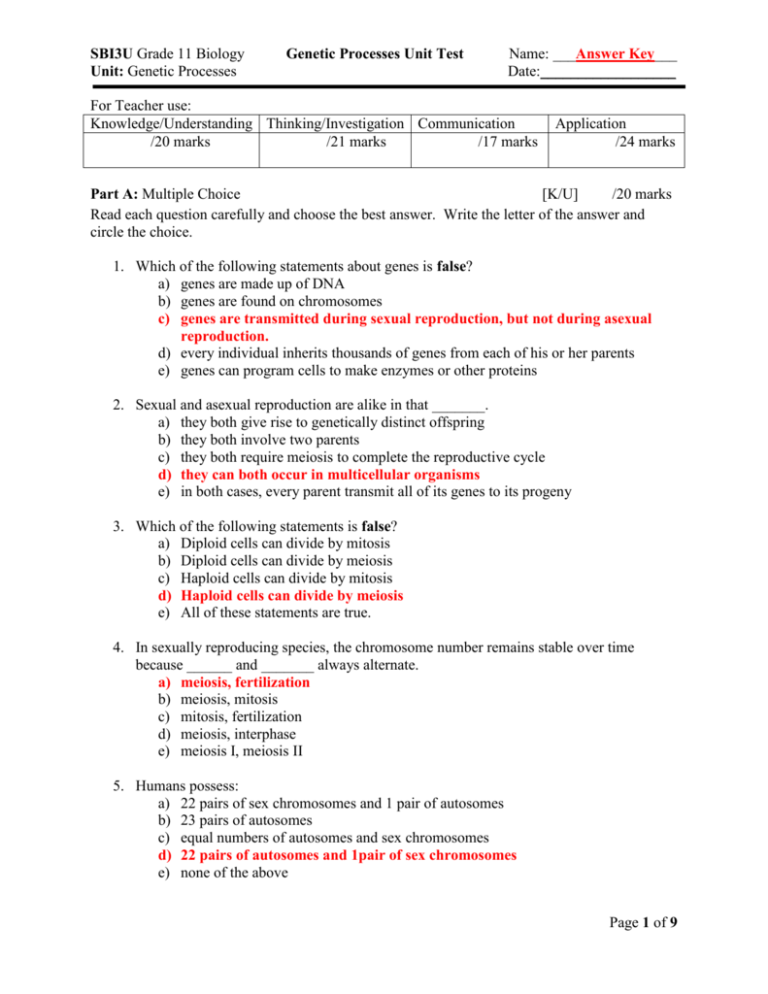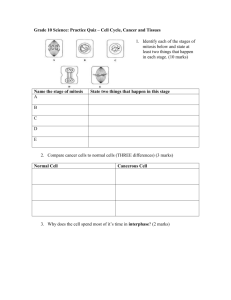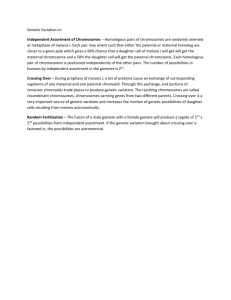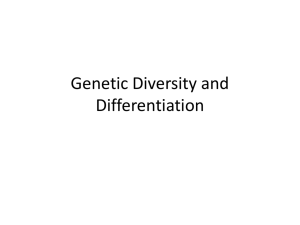Answers SBI3U Genetic Processes Unit Test
advertisement

SBI3U Grade 11 Biology Unit: Genetic Processes Genetic Processes Unit Test Name: ___Answer Key___ Date:__________________ For Teacher use: Knowledge/Understanding Thinking/Investigation Communication /20 marks /21 marks /17 marks Application /24 marks Part A: Multiple Choice [K/U] /20 marks Read each question carefully and choose the best answer. Write the letter of the answer and circle the choice. 1. Which of the following statements about genes is false? a) genes are made up of DNA b) genes are found on chromosomes c) genes are transmitted during sexual reproduction, but not during asexual reproduction. d) every individual inherits thousands of genes from each of his or her parents e) genes can program cells to make enzymes or other proteins 2. Sexual and asexual reproduction are alike in that _______. a) they both give rise to genetically distinct offspring b) they both involve two parents c) they both require meiosis to complete the reproductive cycle d) they can both occur in multicellular organisms e) in both cases, every parent transmit all of its genes to its progeny 3. Which of the following statements is false? a) Diploid cells can divide by mitosis b) Diploid cells can divide by meiosis c) Haploid cells can divide by mitosis d) Haploid cells can divide by meiosis e) All of these statements are true. 4. In sexually reproducing species, the chromosome number remains stable over time because ______ and _______ always alternate. a) meiosis, fertilization b) meiosis, mitosis c) mitosis, fertilization d) meiosis, interphase e) meiosis I, meiosis II 5. Humans possess: a) 22 pairs of sex chromosomes and 1 pair of autosomes b) 23 pairs of autosomes c) equal numbers of autosomes and sex chromosomes d) 22 pairs of autosomes and 1pair of sex chromosomes e) none of the above Page 1 of 9 SBI3U Grade 11 Biology Unit: Genetic Processes Genetic Processes Unit Test Name: ___Answer Key___ Date:__________________ 6. What is the result when a diploid cell undergoes meiosis? a) two diploid cells b) two haploid cells c) four diploid cells d) four haploid cells e) two haploid cells and two diploid cells 7. Synapsis occurs during ______. a) anaphase I b) prophase I c) cytokinesis d) prophase II e) metaphase I 8. During anaphase I ______. a) homologous chromosomes separate and migrate toward opposite poles b) sister chromatids separate and migrate toward opposite poles c) nuclei reform d) chromosomes line up in one plane e) the cell is haploid 9. Which one of the following occurs in meiosis, but not mitosis? a) The cells formed have the same combination of genes as found in the initial cell b) Homologous chromosomes separate c) The nuclear envelope disappears d) Sister chromatids undergo disjunction e) A spindle fibre forms 10. A tetrad is made up of: a) two chromatids from one chromosome b) one chromatid from two homologous chromosomes c) four chromatids from two homologous chromosomes d) one chromatid from one chromosome e) none of the above 11. The major contribution of sex to evolution is ______. a) It is the only mechanism for species to reproduce b) It provides a method to increase genetic variation c) It provides a way in which somatic mutations can be inherited d) a) and b) are correct e) a) and c) are correct 12. The law of independent assortment _______. a) states that the alleles at different loci segregate independently form one another during a dihybrid cross b) can account for a 9: 3:3: 1 ratio seen in the F2 generation Page 2 of 9 SBI3U Grade 11 Biology Unit: Genetic Processes Genetic Processes Unit Test Name: ___Answer Key___ Date:__________________ c) applies only to genes that are present on different chromosomes (or behave as if they were) d) a) and b) are correct e) all of the above are correct 13. Drosophila is a useful organism for genetic studies for all of the following reasons except: a) They have a long generation time b) A single mating can produce many offspring c) They have a small number of chromosomes. d) Drosophila chromosomes can be easily distinguishable under a light microscope e) All of the above. 14. Wild type is referred to as: a) the most common phenotype in the natural population b) the most extreme mutant phenotype observed in an experiment c) any mutant genotype d) a kind of chromosomal deletion e) extranuclear genes 15. What is the probability that a male will inherit an X-linked recessive allele from his father? a) 0% b) 25% c) 50% d) 75% e) 100% 16. Karyotypes are useful for: a) determining whether or not the chromosomes are normal in number b) determining whether or not the chromosomes are normal in structure c) determining the sex of an individual d) all of the above e) none of the above 17. Which type of chromosomal alteration is responsible for the disorder Cri Du Chat? a) inversion b) duplication c) genetic imprinting d) deletion e) translocation 18. Which one of the following is the only known viable human monosomy? a) XYY b) XO c) YO Page 3 of 9 SBI3U Grade 11 Biology Unit: Genetic Processes Genetic Processes Unit Test Name: ___Answer Key___ Date:__________________ d) XY e) XXY 19. A woman is red-green color-blind. What can we conclude, if anything, about her father? a) We have too little information to tell b) There is a 50% probability that he has normal vision c) He is red-green color-blind. d) He has two Y chromosomes. e) None of the above. 20. Cystic fibrosis, which is usually lethal before the age of reproduction, is a homozygous recessive trait. Why do cases continue to arise, even though people with the disease rarely live to reproduce? a) Because new mutations continually introduce this harmful condition into the population b) Because the harmful allele “hides” within heterozygous individuals, one fourth of the offspring of two heterozygotes would be afflicted c) Because mosquitoes can transfer the disease form person to person d) Because people continue to make inappropriate lifestyle choices e) none of the above Part B: Short Answer 1. Fill in the following chart. [T/I] /21 marks [C] Mitosis Number of times the cell divides Number of daughter cells /17 marks [A] [T/I] /5 marks /7marks Meiosis 1 2 2 4 Number of chromosomes compared to the parent cell Hint: use proper terms Type of parent cell Same as parents diploid Half as many as the parents haploid Any somatic cell Reproductive cell Type of daughter cell Any somatic cell Gamete (egg or sperm) 46 23 no yes Number of chromosomes in daughter cell Do homologous chromosomes pair? Yes or No? Page 4 of 9 SBI3U Grade 11 Biology Unit: Genetic Processes Genetic Processes Unit Test Name: ___Answer Key___ Date:__________________ 2. Draw a diagram to illustrate the type of non disjunction that would cause a normal female and a normal male to produce an XYY offspring and an XO offspring and indicate the name of the resulting two genetic disorders. [T/I] /2marks [C] /4 marks Normal female XX X X XXY Klinefelter syndrome Normal Male XY XY (4 marks for diagram) O XO Turner’s syndrome (2 marks for naming) 3. A man and a woman both have normal vision. They have three offspring, all of whom marry people with normal vision. The three offspring and their children are as follows: a) A son with red-green colour blindness who has a daughter with normal vision b) A daughter who has three sons with normal vision c) A daughter who has one red-green colour blind son and one son with normal vision Draw the pedigree for this family, indicating the affected people and the carriers. [T/I] /5 marks (Correct labelling) Carrier female [C] /5 marks (quality of diagram) Colour-blind male Page 5 of 9 SBI3U Grade 11 Biology Unit: Genetic Processes Genetic Processes Unit Test Name: ___Answer Key___ Date:__________________ 4. Two couples had baby boys in the same hospital at the same time. There was a mix-up in the hospital nursery. Using the information given in the table below, explain which baby belongs to which family. Be sure to include Punnett squares in your answer. Blood Type [T/I] Parent 1 B Parent 1 AB /5 marks (Correct assignment) Parent 2 B Parent 2 A [C] Baby 1 A Baby 2 O /5 marks (Quality of explanation) Determine the genotypes of the blood types of the parents and babies. Parent 1 Parent 1 Parent 2 Parent 2 Blood Type B AB B A B A B B Genotype I i I I I i IAi Baby 1 A IAi Baby 2 O ii Use Punnett Squares to determine the possible genotypes of the babies Couple 1 Couple 2 B I i IA IAIB IA IAi IB IBIB IBi i IB I I IBi i IAi ii A B Therefore, Baby 1 with Type A blood belongs to Couple 1 and Baby 2 with Type O blood belongs to Couple 2. 5. A breeder wants to find out whether or not a certain golden retriever is a carrier for an undesirable recessive trait. Explain what the breeder can do to find out. Show all work using Punnett squares if necessary. [A] /3 marks [C] /3 marks (Quality of explanation) Let G be the dominant trait and let g be the recessive trait. To find out if the golden retriever has the recessive allele, breed it with a golden retriever with the homologous recessive trait. Possibility 1 g g Possibility 2 G Gg Gg g gg gg g g G Gg Gg G Gg Gg If the golden retriever is heterozygous i.e. is a carrier of the recessive trait as shown in possibility 1, then 50% of the pups will show the dominant trait and 50% will show the recessive trait. If the golden retriever is homologous dominant i.e. not a carrier of the recessive trait as shown in possibility 1, then all the pups will show the dominant trait. 6. Explain why marriages between very close relatives are illegal in Canada using genetics as the basis of your explanation. [A] /2 marks Page 6 of 9 SBI3U Grade 11 Biology Unit: Genetic Processes Genetic Processes Unit Test Name: ___Answer Key___ Date:__________________ The mating of two genetically related parents is known as inbreeding. Inbreeding results in increased homozygosity which can increase the chances of offspring being affected by recessive or deleterious traits, resulting in an increased risk of genetic disorders. 7. Briefly describe how geneticists would explain the following observations: [T/I] a) a continuous distribution of phenotypes in traits such as eye colour This observation can be explained by dominant and recessive traits. /2 marks b) the expression of an intermediate phenotype This observation can be explained by incomplete or co-dominant traits. Part C: Genetics Problems [A] /19 marks Complete the following genetics problems. Show all your work. Be sure to include Punnett squares in your answers if necessary. 1. A man with type O blood is married to a woman with type B blood. Which blood types can their children have? [A] /3 marks Parental genotypes: ii and IBi or IBIB Possibility 1 Possibility 2 B i i I IBi IBi A I i ii ii i i IB IBi IBi IB IBi IBi IBi = Type B blood and ii = Type O blood Therefore, their children can only have Type O and Type B blood. 2. In horses, black colour (B) is due to a dominant allele and chestnut colour (b) is due to its recessive allele. A pacing gate (T) is dominant over a trotting gait (t). A heterozygous black pacer is crossed with a chestnut trotter. What are the possible genotypic and phenotypic ratios of the F1 generation? [A] /5 marks Let B represent the allele for black colour. Let b represent the allele for chestnut colour. Let T represent the allele for pacing gate. Let t represent the allele for trotting gait. Parental Genotypes: BbTt and bbtt bt bt bt BT BbTt BbTt BbTt Bt Bbtt Bbtt Bbtt bT bbTt bbTt bbTt bt bbtt bbtt bbtt Page 7 of 9 SBI3U Grade 11 Biology Unit: Genetic Processes bt Genetic Processes Unit Test BbTt Bbtt Name: ___Answer Key___ Date:__________________ bbTt bbtt ¼ BbTt Black Pacer, ¼ Bbtt Black Trotter, ¼ Chestnut Pacer, ¼ Chestnut Trotter 3. In cattle when a (RR) red bull is crossed with a (rr) white cow, the heterozygous offspring (Rr) are neither red nor white but roan (red and white hair). Determine the phenotypic and genotypic percentages for the offspring from a cross between a roan bull and a red cow. Show all work. [A] /3 marks Let R represent the allele for red fur. Let r represent the allele for white fur. Parental Genotypes: Rr (roan bull) and RR (red cow) R R R RR RR r Rr Rr Genotypes: 50% RR and 50% Rr Phenotypes: 50% red fur and 50% roan 4. Colour blindness is inherited as an X-linked recessive. Tasting is an autosomal trait in which tasting (T) is dominant to non-tasting (t). A heterozygous taster male that is colour-blind is married to a non-taster female that is a carrier for colour-blindness. Use a complete Punnet square to determine the answer to the following questions. [A] 8 marks: 5 for the complete Punnet square and 3 for the answers to the questions below. a) If they have a daughter, what is the probability that she will be a taster and a colour-blind carrier? b) What is the probability of the couple having a non-taster colour-blind son? c) What is the probability that the couple will have a taster child that is not colour-blind? Parental Genotypes: Male: XCY and Tt Colour Blindness Taster C XC X Female: XCX and tt X XCXC XCX Y XCY XY Colour Blindness 25% XCXC colour blind daughter 25% XCX carrier daughter 25% XCY colour blind son 25% XY normal son t t T Tt Tt t tt tt Taster 50% Tt Taster 50% tt Non Taster Page 8 of 9 SBI3U Grade 11 Biology Unit: Genetic Processes Genetic Processes Unit Test Name: ___Answer Key___ Date:__________________ a) There is a 12.5% (0.25x 0.50= 0.125) chance that the couple will have a daughter who is a taster and a colour-blind carrier. b) There is a 12.5% (0.25x 0.50= 0.125) chance that the couple will have a non-taster colourblind son. c) There is a 25% (0.50x 0.50 =0.25) chance that the couple will have a taster child that is not colour-blind Page 9 of 9







